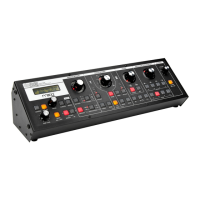Page12
SlimPhattyUser’sManualTheComponents
Page13
SlimPhattyUser’sManualTheComponents
Now let’s take a look at the individual module components that make up the Slim Phatty Synthesizer, start-
ing with the Oscillator section and moving right across the front panel, explaining the features and functions
of the Filter, Envelope Generator and Output sections. Then we’ll cover the Modulation section, the Input/
Output Back Panel, and the User Interface section.
A. The Oscillator Section
The Oscillators are the main sound source of the Slim Phatty. The oscillators in the SP are analog Voltage
Controlled Oscillators (VCOs) that feature a temperature regulation circuit that provides them with excel-
lent tuning stability. The SP’s VCOs can produce a total musical range of 9 octaves!
The Components
Oscillator One serves as a master oscillator to which Oscillator 2 is
tuned. The timbres of the oscillators are adjusted by their variable
waveform (WAVE) controls. There is also a switch for syncing Oscilla-
tor 2 to Oscillator 1, and a control for adjusting the glide rate which is
explained below.
The frequencies of the oscillators are controlled and affected by a
number of sources. The main control source is a ‘NOTE ON’ com-
mand transmitted from an external MIDI controller. The MIDI ‘NOTE
ON’ command is translated into a Control Voltage (CV) that allows
the oscillators to be played in an equal tempered scale. Adding to
that, the SP’s glide circuit can be switched on to slow the CV changes
between notes, resulting in portamento. The CV is then mixed with
the Octave switch CV, the Frequency offset control (Oscillator 2), the
Pitch CV In (if plugged in on the back panel), the fine tune control, and
the output of the Mod Matrix when the “Pitch” destination is selected.
Oscillator Section Controls:
Octave:
Each Oscillator has a switch labeled OCTAVE that selects the relative frequency range. To select the octave,
simply press the switch. Each press of the switch advances the setting, as indicated by the corresponding
LED. When the topmost octave is reached, the next button press cycles back to the lowest octave. The
panel markings 16’, 8’, 4’ and 2’ are octave standards based on organ stops. On the 16’ setting the highest A
on the keyboard is A440.
Oscillator Level:
Each oscillator has a switch labeled LEVEL that allows the analog edit control to adjust the oscillator level.
This allows you to control the relative strength of each oscillator in the mixer from 0 to 100%.
THE COMPONENTS

